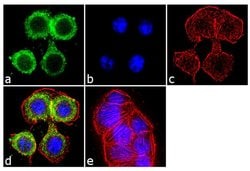Learn More
Invitrogen™ TGFBR2 Recombinant Superclonal™ Antibody (16HCLC)
Rabbit Recombinant Superclonal Antibody
Supplier: Invitrogen™ 710715
Description
This antibody is predicted to react with Monkey and Rabit. Recombinant rabbit Superclonal™ antibodies are unique offerings from Thermo Fisher Scientific. They are comprised of a selection of multiple different recombinant monoclonal antibodies, providing the best of both worlds - the sensitivity of polyclonal antibodies with the specificity of monoclonal antibodies - all delivered with the consistency only found in a recombinant antibody. While functionally the same as a polyclonal antibody - recognizing multiple epitope sites on the target and producing higher detection sensitivity for low abundance targets - a recombinant rabbit Superclonal™ antibody has a known mixture of light and heavy chains. The exact population can be produced in every lot, circumventing the biological variability typically associated with polyclonal antibody production. Note: Formerly called Recombinant polyclonal antibody, this product is now rebranded as Recombinant Superclonal™ antibody. The physical product and the performance remain unchanged.
Transforming Growth Factor, beta receptor 2 (AAT3, FAA3, MFS2, RIIC, LDS1B, LDS2B, TAAD2, TGFR-2, TGFbeta-RII) is a member of the TGF-beta family of receptor Serine/Threonine kinases. It is involved in the regulation of cell proliferation. Mitochondrial ATP synthase catalyzes ATP synthesis, utilizing an electrochemical gradient of protons across the inner membrane during oxidative phosphorylation. ATP synthase is composed of two linked multi-subunit complexes: the soluble catalytic core, F1, and the membrane-spanning component, Fo, comprising the proton channel. The catalytic portion of mitochondrial ATP synthase consists of 5 different subunits (alpha, beta, gamma, delta, and epsilon) assembled with a stoichiometry of 3 alpha, 3 beta, and a single representative of the other 3. The proton channel consists of three main subunits (a, b, c). TGFBR2 encodes the gamma subunit of the catalytic core. Alternatively spliced transcript variants encoding different isoforms have been identified. TGFBR2 also has a pseudogene on chromosome 14.
Specifications
| TGFBR2 | |
| Recombinant Superclonal | |
| 0.5 mg/mL | |
| PBS with 0.09% sodium azide; pH 7.2 | |
| P37173 | |
| TGFBR2 | |
| Protein corresponding to Human TGFBR2 (aa 73-495). | |
| 100 μg | |
| Primary | |
| Human | |
| Antibody | |
| IgG |
| Western Blot, Immunocytochemistry | |
| 16HCLC | |
| Unconjugated | |
| TGFBR2 | |
| 1110020H15Rik; AAT3; AU042018; DNIIR; FAA3; LDS1B; LDS2; LDS2B; MFS2; RIIC; RIIDN; TAAD2; TbetaRII; TbetaR-II; TBR-II; tgf beta receptor 2; TGF-beta 2; TGF-beta receptor II; TGF-beta receptor type II; TGF-beta receptor type IIB; TGF-beta receptor type-2; TGFbeta RII; TGFbeta type II receptor; TGF-beta type II receptor; TGFbeta-RII; TGFBR2; Tgfbr2T; TGFR2; TGFR-2; transforming growth factor beta receptor 2; transforming growth factor beta receptor II; transforming growth factor beta receptor type II; transforming growth factor beta receptor type IIC; transforming growth factor, beta receptor 2; transforming growth factor, beta receptor II; transforming growth factor, beta receptor II (70/80kDa); transforming growth factor, beta receptor II alpha; transforming growth factor, beta receptor II beta; transforming growth factor, beta receptor II delta; transforming growth factor, beta receptor II epsilon; transforming growth factor, beta receptor II gamma; transforming growth factor, beta receptor IIT; transforming growth factor-b type II receptor; transforming growth factor-beta receptor type II; transforming growth factor-beta type II receptor | |
| Rabbit | |
| Protein A | |
| RUO | |
| 7048 | |
| Store at 4°C short term. For long term storage, store at -20°C, avoiding freeze/thaw cycles. | |
| Liquid |
Safety and Handling
Your input is important to us. Please complete this form to provide feedback related to the content on this product.

